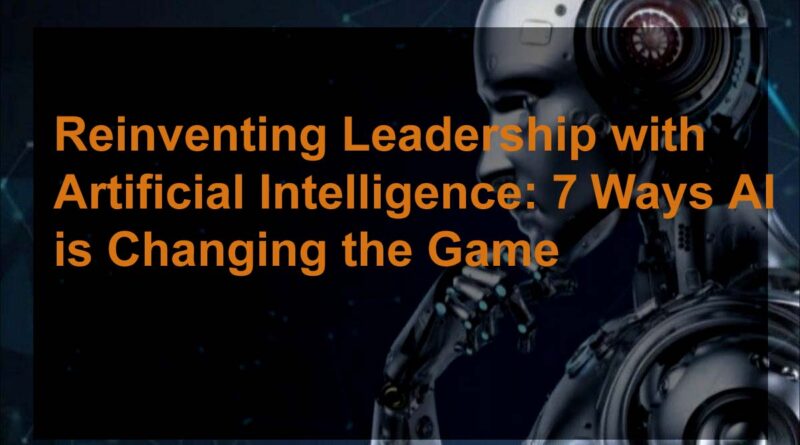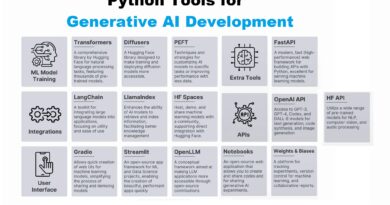Reinventing Leadership with Artificial Intelligence: 7 Ways AI is Changing the Game
AI-Driven Decision Making
AI enhances leadership skills and its impact on the actual life. AI is impacting many aspects of the company, especially leadership to the extent that it is capable of delivering insights and making decisions. It can be applied to assist leaders in forecasting consumer trends and evaluating procedures in search of data-supported opportunities. undefined
Data Analysis. AI allows organizations to process large amounts of information and exhibit high performance in a short period of time. This makes it easier, quicker and more efficient for leaders to make better decisions based on the current data.
Strategic Planning. AI offers leaders applications that can assist them in making more-robust decisions by foreseeing risks and opportunities.
Enhanced Collaboration . With AI technology, information can be exchanged between departments in manners that would not be possible for humans.
Automation . AI can help to manage many routine processes, and leaders do not have to worry about them, focusing on work of great importance.
Improved Decision Making. Due to this, AI can enable leaders to make more sound decisions since it provides statistical analysis and accurate forecasts because of the increased data input.
Better Customer Service. AI can enhance the customer experience in that it enables the business to provide swift and proper answers to questions made by customers.
Efficient Resource Management. Some specific benefits of using AI in businesses include optimized allocation of scarce resources due to process automation and forecast of demand.
Streamlining Communication with AI
Artificial intelligence (AI) is swiftly altering the overall management approach by acting as the guide for organizations to enhance business communication. AI can help enhance leaders by supplying them with the information and analytics that assist in refining their leadership activities and enhancing their effectiveness and productivity. It is this change in the approach to leadership that is causing shifts in how companies operate and compete in the global market, as AI is taking on a role in real life situations as has not been experienced before.
First of all, with the help of AI, the management is able to more effectively track the team’s activity and keep the productivity indicators high. Getting good data about the performance of a team is easy for leaders and some of the information that one can get includes the duration taken to do a certain task and how often certain tasks are done within the required time of the day. Using this information, managers can set goals for change, and establish procedures to help the company become more effective and achieve higher levels of effectiveness within a team or within various departments. Furthermore, it also expands the possibility for leaders to learn about performance of individual team members, yet decisions have to be made and obstacles have to be resolved.
AI can also be used to minimize the amount of time managers spend on rather trivial tasks that would still require many hours to complete. Through leadership, more can be achieved while the individual effort that go into malicious factionalism are reduced through the use of technology. In the words of this theory, it releases their time and allows them to make strategic decisions and allocate resources as they will. Besides, using AI technology, leaders receive some enhanced insights into operations which is crucial because they see clearly and get oriented regarding what occurs in various departments at a given time point.
Furthermore, it enables leaders to continue being in touch with their staff whenever despite not being physically present through functions such as voice-driven assistant or messengers that send alerts when something requires attention. It allows everyone to stay informed at all levels without necessarily requiring that everybody communicates their status to others; it also offers a method of coming to a prompt decision and contributing feedback in instances where they are required.
Overall, AI is leading to the transformation of leadership through providing corporations with effective instruments to manage the flow of communication and monitor the process with a close focus on timely detection of issues that require employers’ attention. With these capabilities business decisonmakers have more information at their disposal than was perhaps ever available and the information required to make decisions is more easily accessible to all, requiring less effort on the part of all involved.
Increasing Employee Engagement through AI
AI is indeed bringing a change in the organizational practices of leadership and employees, and bringing better leaders and a better work culture. With an increased implementation of improved technology that includes the use of Artificial Intelligence in encouraging cooperation and communication at the workplace, a new leadership character is being created. undefined
1. Automated Performance Management
Poor performance management is one of the biggest responsibilities of any manager as they need to monitor other subordinates’ performance frequently. Since there are artificially intelligent systems that deal with performance management, the leaders can be assured of having correct data on employee performance at any given time. This means that leaders are able to easily determine the areas where vulnerabilities may ensue and address them accordingly.
2. Improved Employee Engagement
Another way of enhancing the level of employees’ engagement is the adoption of advanced technologies like chatbots or virtual assistants. These may be very useful in establishing rapport between the workforce through providing them with answers to their questions or issues within a short span of time and also getting them the information they may need from their workplace in a timely manner. It also makes work experience for each employee more oriented and thus leading to stronger bonds for the leader and the members.
3. Enhanced Decision Making
These systems can easily present such information to the leaders in real time so that they can make the right decisions in equally real time. For instance, the use of AI enabled analytics can assist in offering predictive analysis that can help managers gain early insights into likely risks or opportunities, thus enhancing the ability of organizations to control specific decision making processes.
4. Increased Transparency
When it comes to using AI in the organization, facilities like sentiment analysis help the manager get a feel of what everyone is feeling about their working environment or the project they are working on at any given period. This essentially gives leaders the power to respond to any complaints that may be voiced by employees without any undue delay, thus strengthening trust between the different departments and possibly enhancing productivity over the longer-term.
- Improved Training Programs
With the help of machine learning algorithms, one can design personalized courses designed for each employee depending on his abilities and demands. It contributes to the guarantee of the continuity and relevance of such training for the employees and, at the same time, enables leaders to better track progress and intervene to provide feedback when necessary for further development to the benefit of each team member .
6 More Efficient Communication
For example, in case of project management, AI can be used to circulate emails or notifications at pre-specified time or frequency, thus relieving the burden of co-ordination from team leaders and enhancing the pace of response with cost benefit. .
7 Transparency At every level
Ai technology offers group wide visibility of each employee’s contribution to a particular project through predictive analyses, which in turn assist decision makers obtain greater accuracy as it relates to resource allocation thus enriching transparency at all organizational levels and hence ensuring optimal results because of efficient utilization of resources.
In conclusion, the application of artificial intelligence has created new opportunities for redesigning leadership approaches and increasing collaboration among teams through the use of feedbacks such as performance reports, mood tracking & analyzing and monitoring discussions in various platforms.
With these advances in technology, many benefits have been realized helping shape the working environment for everybody involved be it through the use of chat bots to boost on communication or even through the use of machine learning to boost on logistics.
In conclusion, the integration of artificial intelligence enables organizations to foster better relationships between the diverse teams besides enhancing productivity at each stage as it leads to higher productivity and customer satisfaction. This article was meant to focus on the area where AI impacts the leadership of organizations and brings improvements to employee engagement as well as increases the levels of transparency within organizations.




